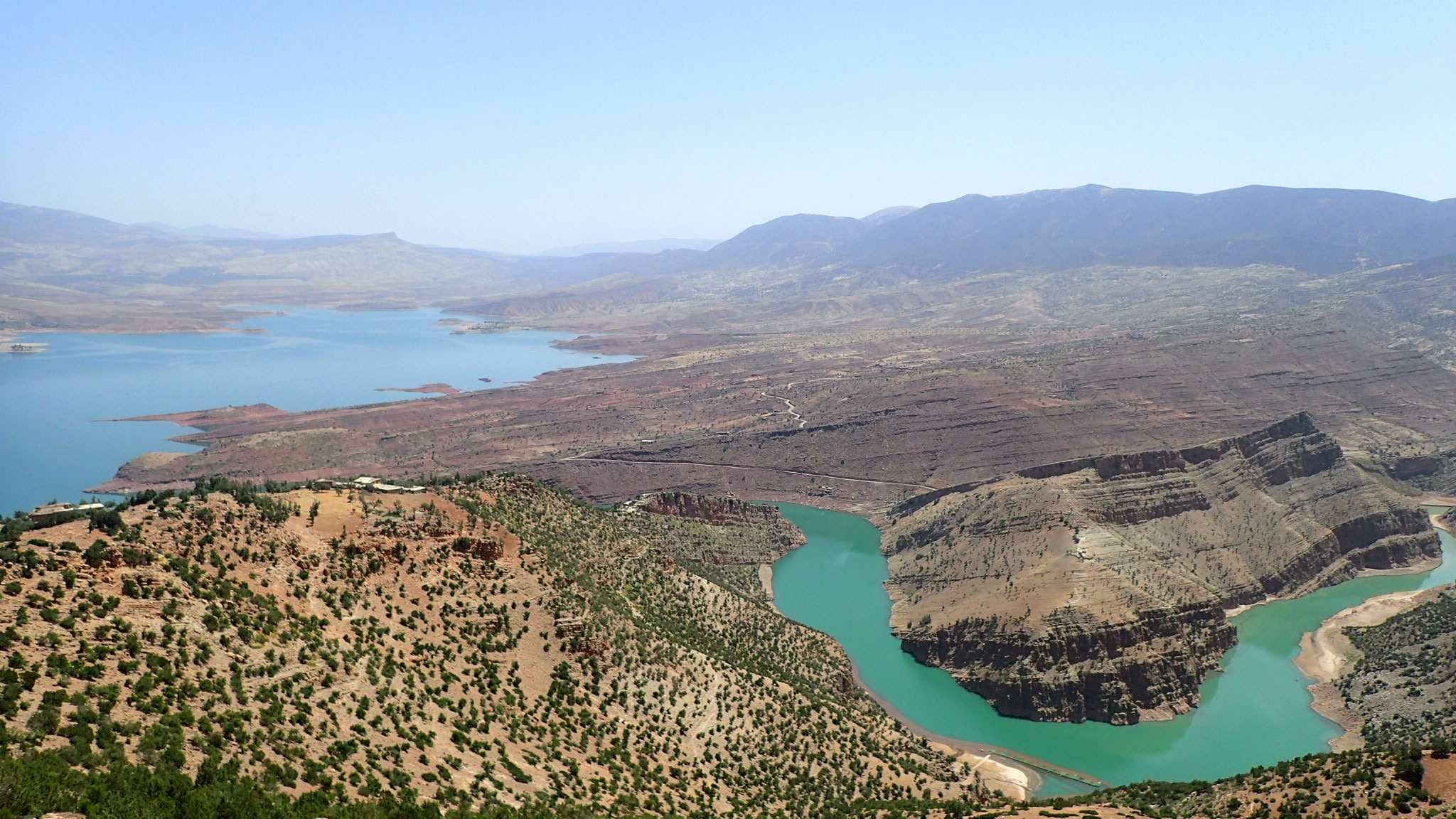To my cyclo-tourist friend looking for its next travel: stop searching! Morocco fits everything that a bike traveler is looking for: welcoming people who overtake with a good margin, a few climbs in an impressive scenary, a rich and varied culinary culture, an exotic country, and it is also at the gates of Europe! At the end of May I left my friend Pierre in Rota in the Bay of Cadiz with a new goal: cross Morocco from the north to Agadir and attempt the crossing of the Atlantic by boat-stop. Those two unscheduled weeks were magical! Moroccans are of a natural kindness and mutual aid is part of their culture. Every night I ended up at a stranger’s house to share the “ftour”, typical Ramadan dinner. Here is the story of an adventure as we love them!
Cultural jetlag
On May 23, I arrive on the African continent, in a country I had not been in the past. Having not planned to go there in the first place, I knew nothing of the country, nor of the “cycling” routes. Fortunately, Eric (from Caldas), advised me their itinerary dating from … 2006 ! But I don’t think the country has changed much since then! It’s also the middle of Ramadan when I arrived, so the way the country works is a little different. For a month, Moroccans (and all Muslims) will eat one or two meals a day, after sunset or before sunrise. Water is also prohibited except for sensitive people (babies, pregnant women, elderly,…). Work schedules are then adapted (in banks for example), all restaurants and cafes are closed during the day (except in touristic places). As a consequence, some people are irritable at the end of the day… The summer makes the days hotter so I adapt my pedaling plan to the sun: first pedal stroke around 5:30 (usually 6am) and then nap between 2pm and 3pm. At the end of the day, Moroccans are quite tired, but I was lucky enough to arrive in the middle of Ramadan, so they are a little used. Once the sun sets, the atmosphere completely changed: place to the gargantuan ftour! Once swallowed up, the energy rises in the people, the streets fill up children playing football, the terraces are full, the market too. Nightlife. For my part, I am exhausted by a long day of cycling, I usually fall asleep around 9pm or 10pm, at the beginning of the festivities.
Warning
Moroccans are very proud of their country, and they are right! They are also often the ones who warn me about… Moroccans! Beware, Moroccans are thieves, don’t trust anyone, etc… I think the urban legends with unfortunate ending have good taste here! So much so that as soon as I arrive, I am advised not to pedal on the national roads: “during Ramadan, Moroccans are crazy on the road, they drive even worse than usual!”. I even meet an American at the Tangier hostel who survived two serious car accidents. He, too, tried to discourage me from cycling on the road.
As neo-cardrivers, Morrocans are sensitive to the marketing propoganda of manufacturers: the car is freedom and speed. This is why the number of deaths in Morocco is almost as high as in France with a car fleet 7 times less (that said the number of fatal accidents is surely less as the filling rate is at least 3 times higher here) 1.
However, their behaviour towards cyclists is more than respectable (to be nuanced in the city and towards local cyclists)! Drivers usually take good safety margins to overtake and encourage me with a honk accompanied by a broad smile. The icing on the cake is the road state: the national roads are wide and in good condition (with a broad emergency line); more and more secondary roads are paved (thanks to the development of the car I admit).
In short, it’s a pleasure to ride in Morocco!
Chefchaouen,the blue village
The original program is to reach Tetouan from Tangier and sleep there. But the good shape and the wind make me arrive at 1pm in Tetouan after 3 hours of pedaling! So I decided to push a little, it goes up a lot but it’s not so steep. The arrival in Chefchaouen is magical but very hard… and the police check did not go as planned: arriving around 8pm the officers were in the middle of Ramadan dinner, and invited me to share their meal: my first ftour! They didn’t have to offer it twice to the hungry cyclist that I am. With a full stomach I get back in the saddle for the few kilometers remaining, in the rearview mirror the officer says to me: “Welcome to Morocco!”.
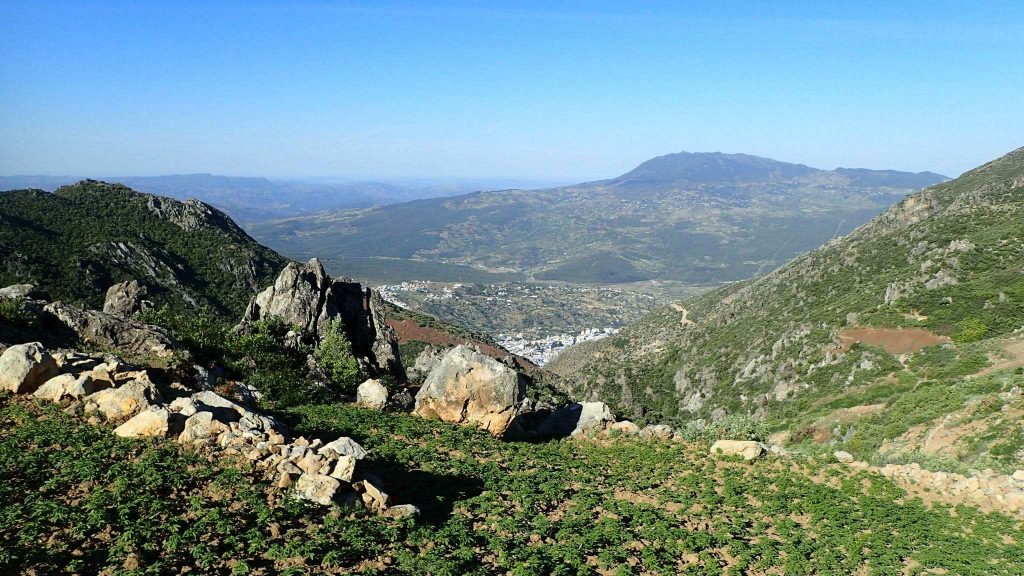
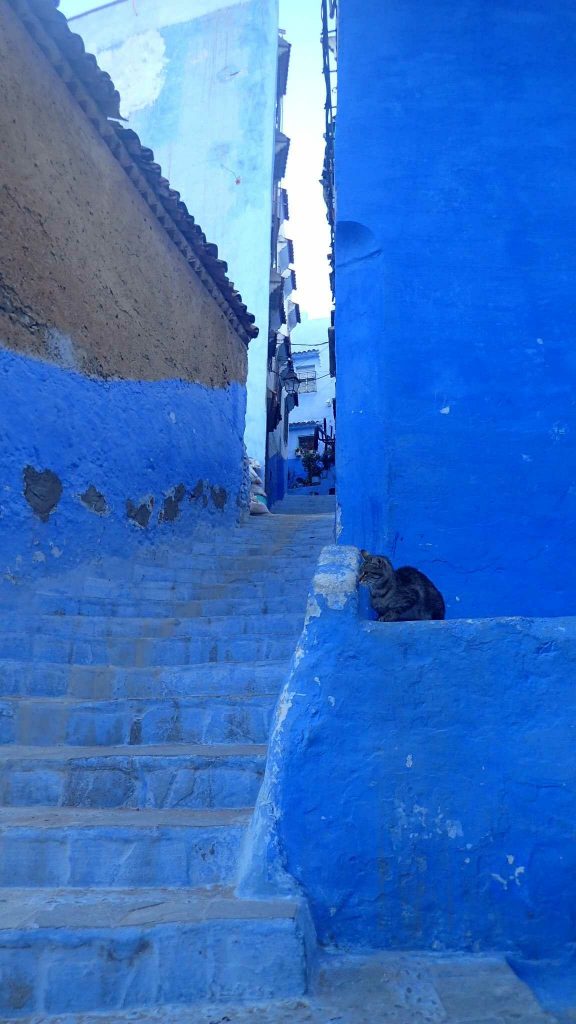
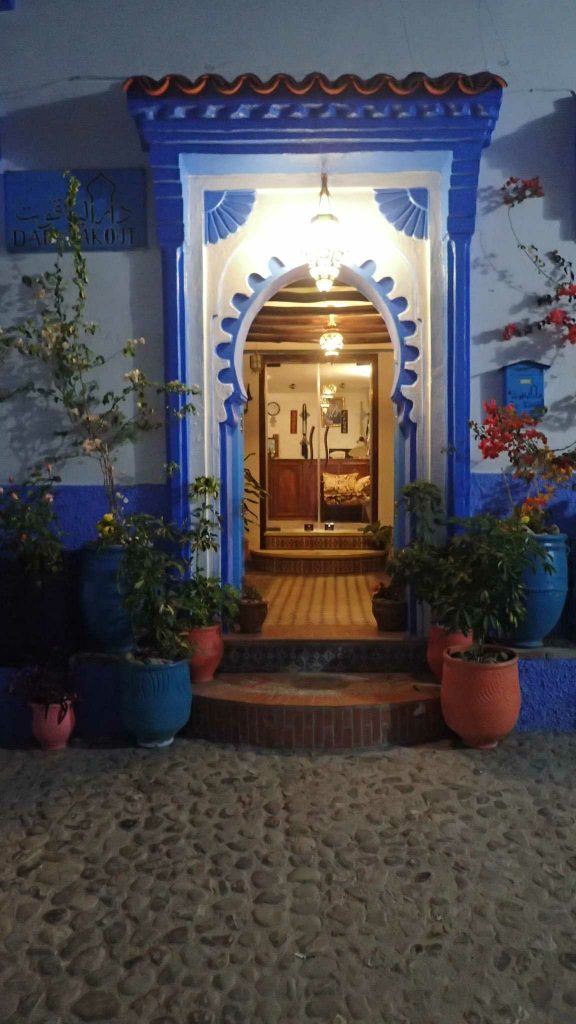
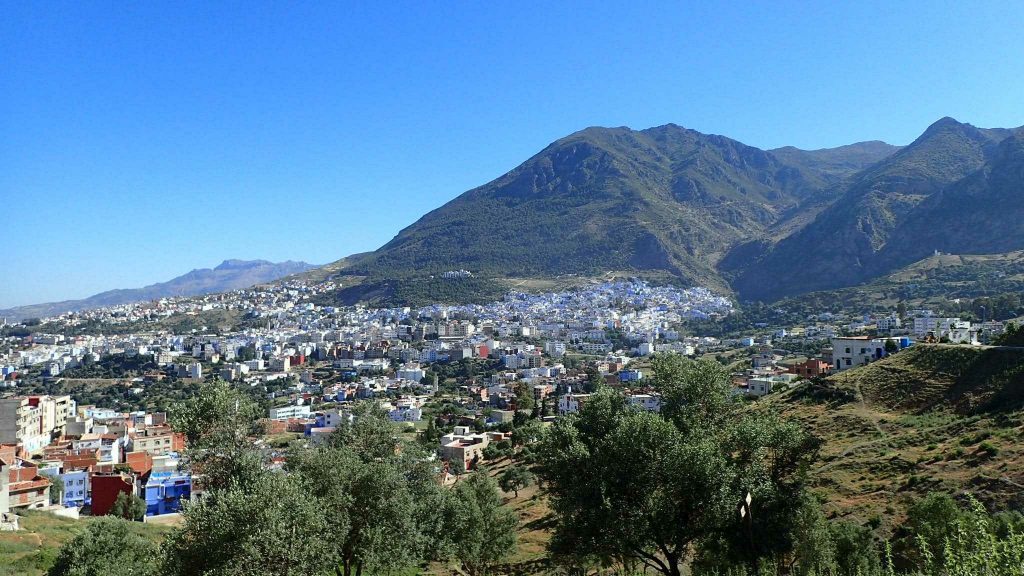
The next day I decided to explore the surrounding mountains. The day before the policeman told me about the bridge of God, a natural bridge on the other side of the mountain. This makes a nice hike of 30 km and the return can be done by taxi. The ascent of Chefchaouen, the summit that monitors of the eponymous city is also on the agenda.
Ski day?
The cycling rhythm is always the same: 3 days pedaled followed by 1 day resting. The next resting stage is Azrou, a village known for its forest and ski resort! My route so far crossed Jorf-El-Melha and Moulay Idriss Zerhoun. Two nights a little difficult: the first in a gas station due to lack of accommodation offers (the prosperous night activity due to Ramadan did not help to sleep well) and then a short night at a local’s in Moulay Idriss. I was happy to arrive in Azrou!
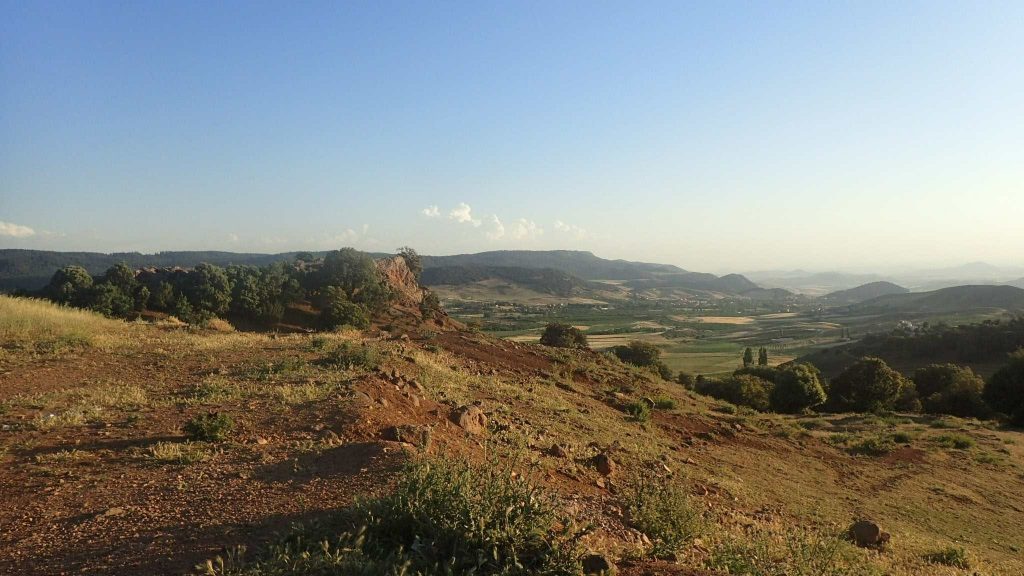
The surrounding forest has an attractive aura on me, so I decide to go for a bike ride. What turns out not to be such a good idea! The steep and gritty slopes are not suitable for recumbent cycling… So I’ll pass it most of the time walking. This test will have had the merit of showing the limits of my bike even without luggage. In the middle of the forest, I met this young Swiss couple. A little hippie on the edges, they travel by van, and live with the minimum of money. One more beautiful encounter.
bin ouidane dam
The departure from Azrou is very pleasant: a long descent during the cool morning. The scenery is incredible between Azrou and M’rirt. But the closer I get to the south the warmer are the mornings, breaks in the early afternoon are more and more necessary. In the evening I decide to bivouac because the hotels are expensive and there are no alternatives… I find a nice little corner near the River Oued Srou and I start setting up the tent once I arrive. Obviously this is not very discreet and the owner of the place comes to join me a few minutes later. Mohammed lives in the house across the road with his parents and siblings. He does not mind me to bivouac here, in addition the place is safe! He’s quite shy, but we manage to understand each other. He offers me two eggs at first and then I will spend the evening at his house with his brother and we will enjoy the ftour. I will leave them relatively early to enjoy a good night’s sleep.
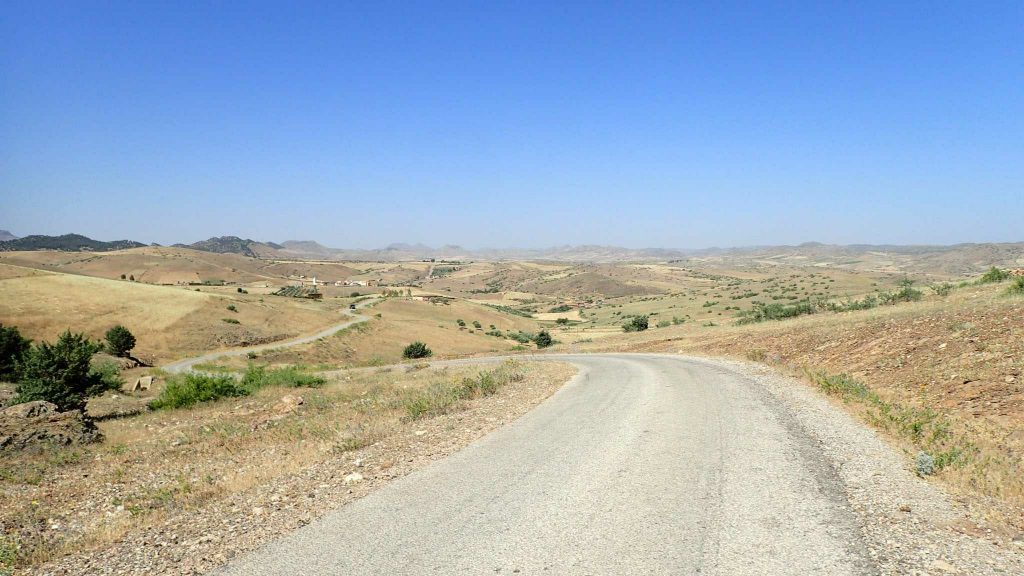

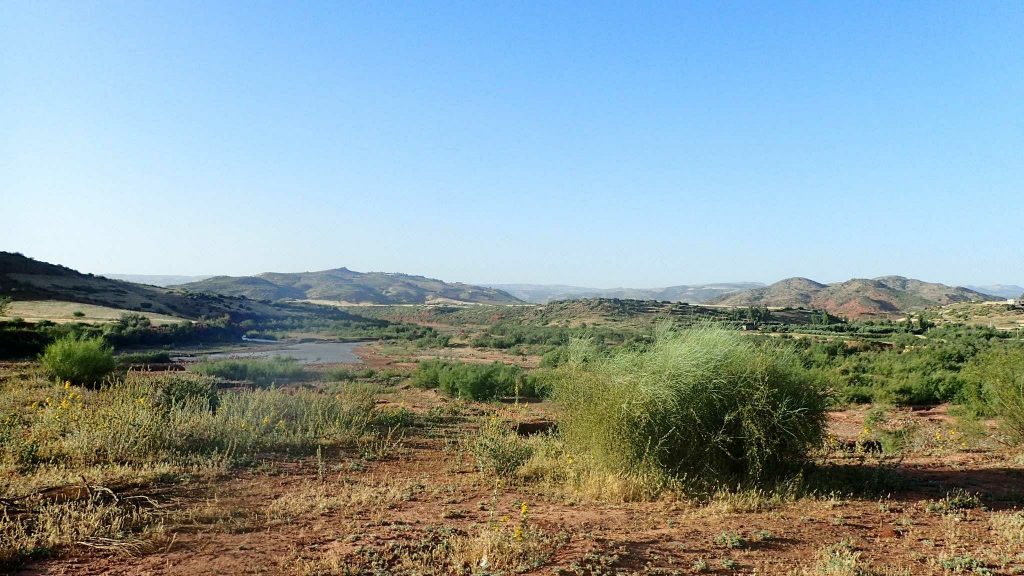
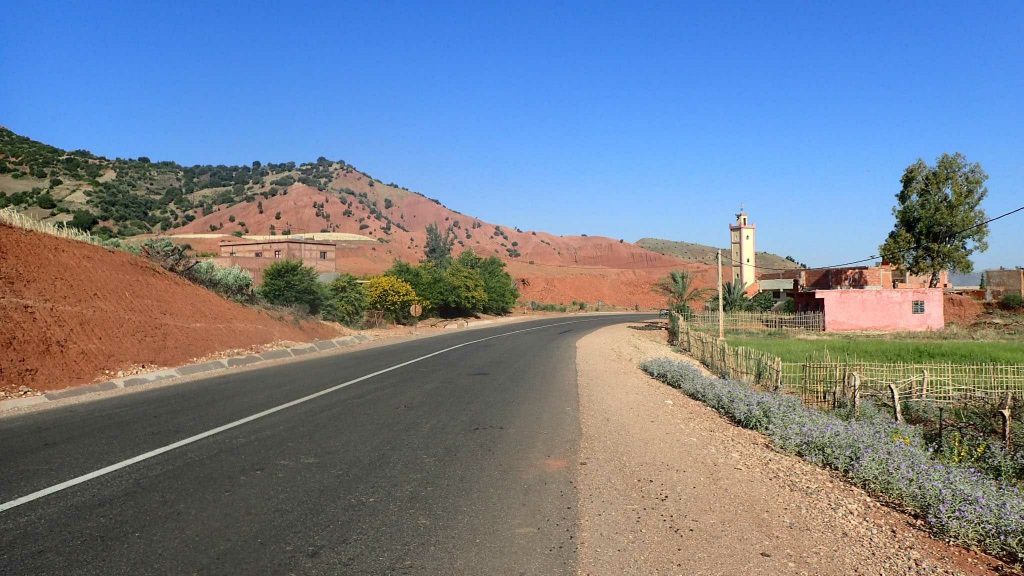
One more adventure awaits me for my evening in Tgazirt. I was looking for a bivouac site near a river to shower and I landed in this small village. A dirt road leads to a natural swimming pool where the children of the village wade. The tranquility will wait! Beautiful bunch of kid, who does not understand that my Arabic is limited, nor that I can not believe in Allah! They’ll even try to convert me. At nightfall, I decide to sleep without a tent (a little lazy and I want to see the sky). Will I survive the wild dogs? Or will the frogs eat me? Barely asleep I hear people. The young children came back to urge me to set up the tent, their worries convinced me. Once inside, another troop arrives. With a gift: a traditional bread and a bottle of iced water. I will eat half tonight and the rest at breakfast, plus it’s my favorite bread, it looks like a pancake but has a square shape!
A 700m climb is on the programme today, to reach the lake of Bin Ouidane. As the announced temperatures approached 40°C the first pedal stroke started at 5am. The road goes down to Afourar from where the climb begins. And let’s go for 15km of suffering! I do not know why but this climb was really hard (while I do not have much in the bags, apart from the paraglide). In addition, I had the best break before the ascent. At a crossroads a man calls me: “Salam! Come over there!” As the time corresponded well with the morning break and that I had half watermelon in the bags, I stopped to talk with this manager of a logistics company. Immediately he hands me a bottle of fresh water. Of course, he is interested in my bike. Seeing me taking the watermelon out of my bag he also offers me fresh quarters from the fridge, they are delicious! I will leave with dry dates, if it’s every day like this, I won’t have to buy food anymore!
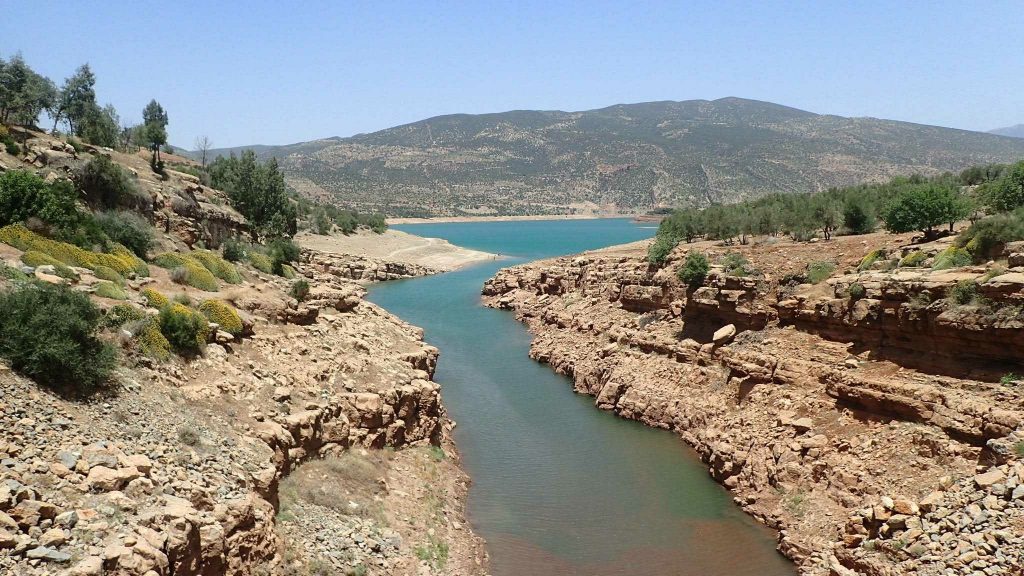
It will take me several hours to get to the end of the climb. But the descent (as often) is beautiful, and a good fresh coke awaits me. In these small grocery stores that can be found everywhere, even in the most remote places! And what can this drink do good after 3-4 hours of effort in the middle of the desert! I gobble up 1 to 2L of soda a day when the thermometer rises above 30.
Arriving at the lake, I hesitate between 3 campsites: I had chosen one at the beginning (randomly), but two others appeared on the map when I arrive. The first one is a bit far from the lake but cheap. I will not visit the selected one because I stopped at the closest to the lake. Not really official, this campsite is more is more someone’s garden but… The owner will invite me for the ftour every evening. An invitation or rather an order but I do not have to be prayed to eat! In addition, the proposed chicken tagine is a delight. What spoils the first dinner (and the second) is the TV! Very little exchange with the family, would it be my presence that prevents them from discussing?
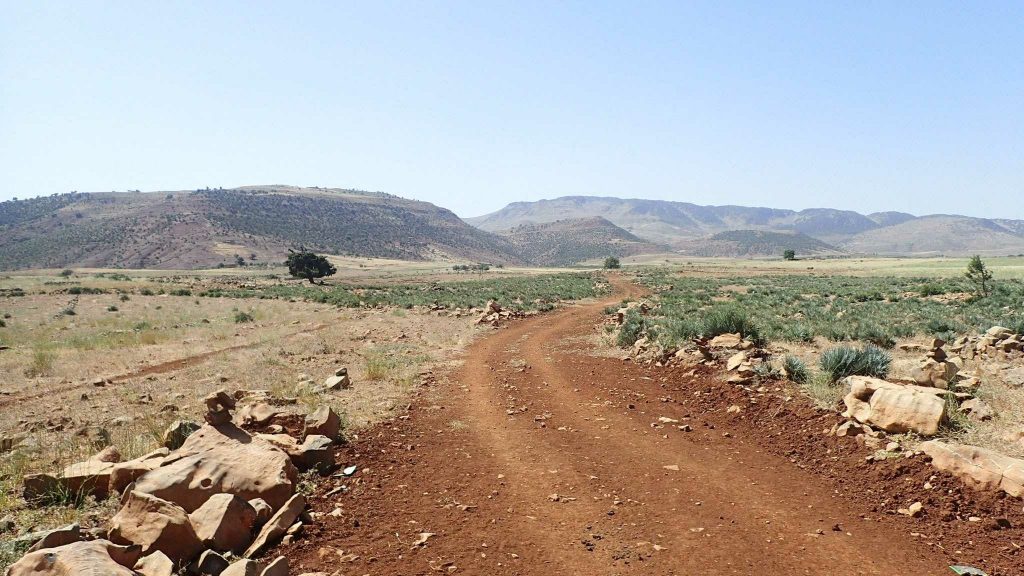
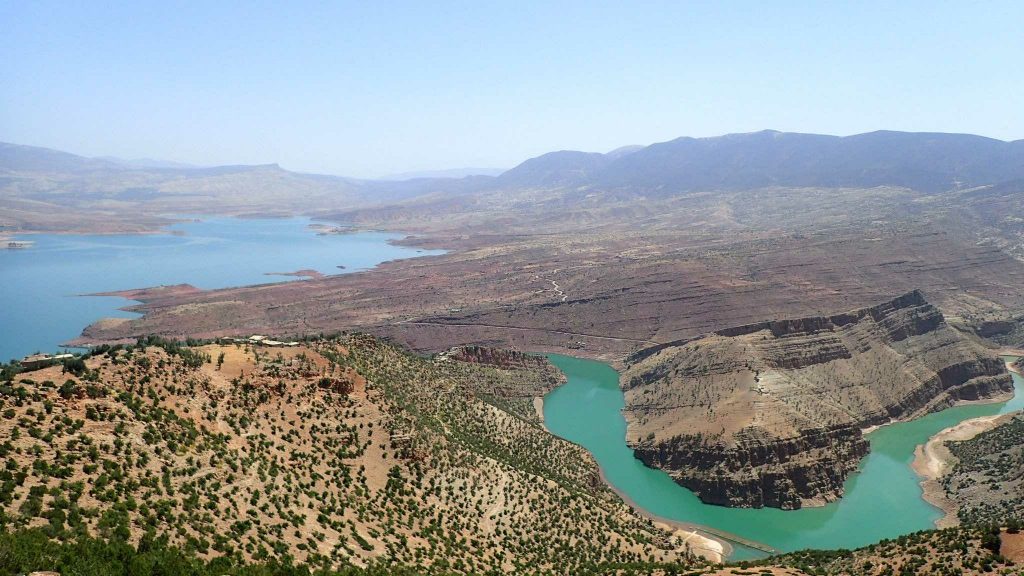
The next day, I ask if I can pay in the evening, knowing that I will leave early the next morning. The manager offers to join him on the terrace after the ftour. This is the meeting point for pipe and hashish smokers. Eight other men join us shortly after. In this regard, Morocco is a major producer of hashish, whose consumption is prohibited by the Koran, some say.
A little piece of Atlas
The 700m of climb went well today! So 15 degrees less makes it easier! The rest of the day goes smoothly, crossing a small desert area, from where a river rises. This is where I planned the swim break, at the hottest hours. The Oued Lakhdar, the green river flows in the right place, I reached at the right time! A group of young people loathe on its edges, I join them. A little distant at first, I want to read a little, they will approach me before leaving. The older one speaks French, and another younger one as well. We discuss a little bit about my vision of Morocco and its poverty. I feel a little uncomfortable. The youngest also offers me to spend the night at his house and have dinner with his family. But I decline politely because I have to move forward… plus the sky becomes threatening in the direction I’m heading. The wind strengthens and the sky darkens quickly. Fearing to be caught in the storm, I stopped in a village to bivouac. As always, my discretion attracts a group of children. Teenagers join them later and still invite me to dinner. The best ftour so far. They are a family of 6 children, 3 girls and 3 boys. Dinner is a delight (with fruit salads and curry-filled breads).
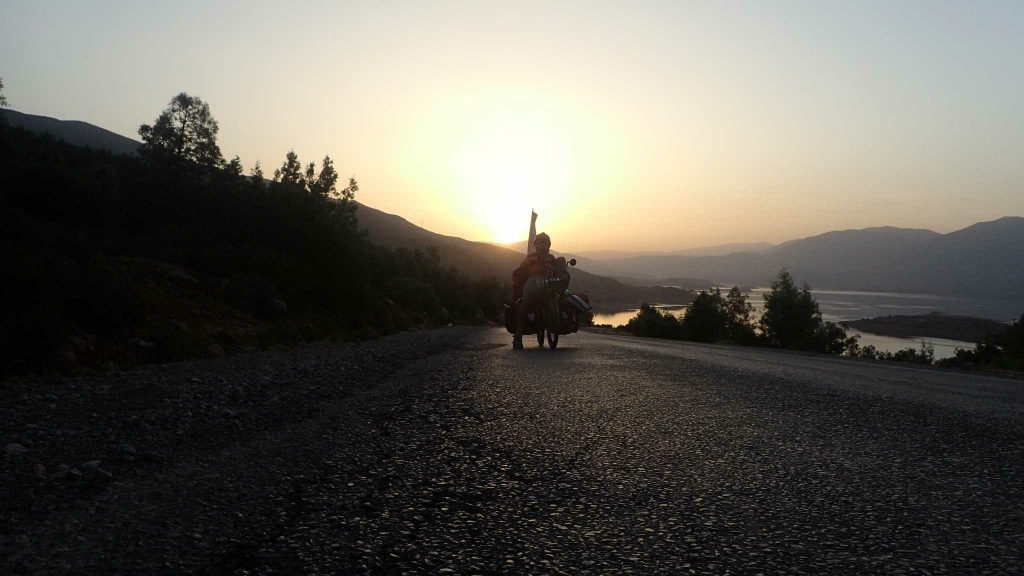
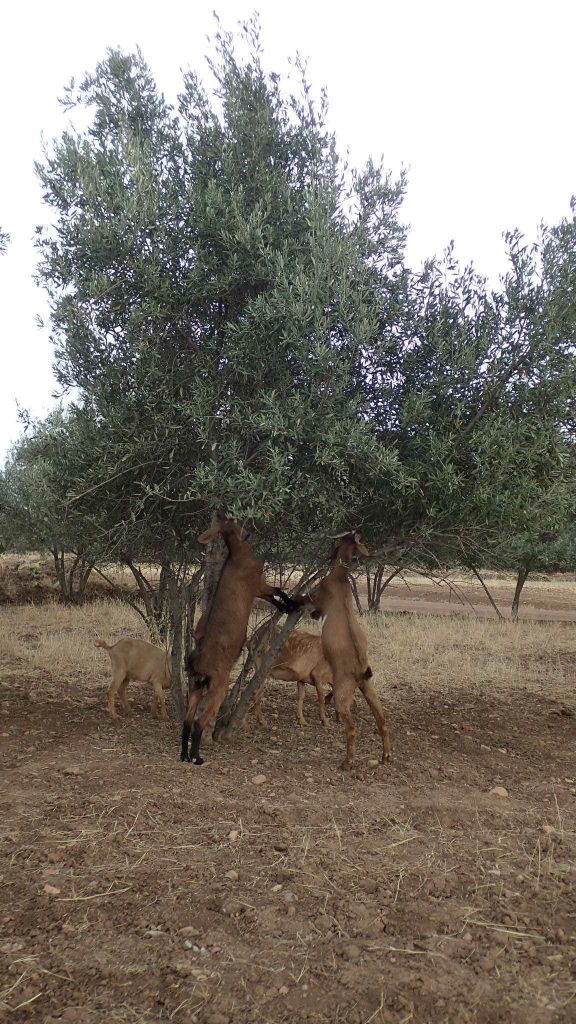
Every pedal strokes get me closer to the Atlas! Desert landscapes to starboard and large mountains to port. A good swim before arriving will make the break all the more enjoyable.
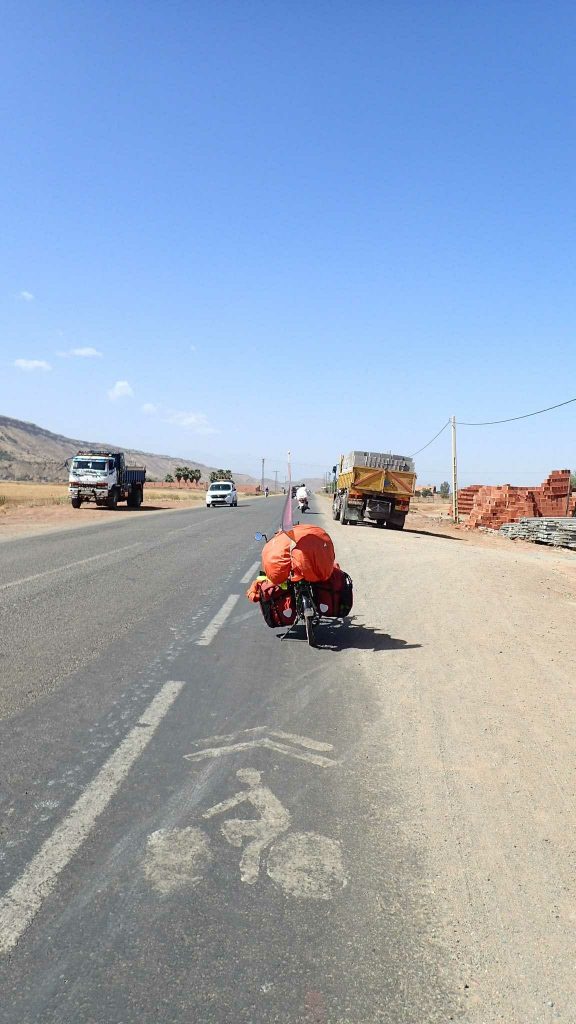
Asni is a small village not far from one Toubkal hiking start (Imlil). The hostel is simple, but very cheap!
I take advantage of my “rest” to hike to Moulay Brahim via the plateau. Very pretty, I’ll even come across little turtles on the way. Today it is Eid Mubarak, so everything is closed. Muslims celebrate the end of Ramadan.
I found a mountain guide on Asni who could try the Toubkal ascent on a day. This summit is the roof of Morocco, culminating at 4167m. It is advisable to climb it over two days, but the prices are not compatible with my budget (just over 100 euros with guide and shelter). The guide is mandatory since the murder of two girls in the massif at the end of 2018…
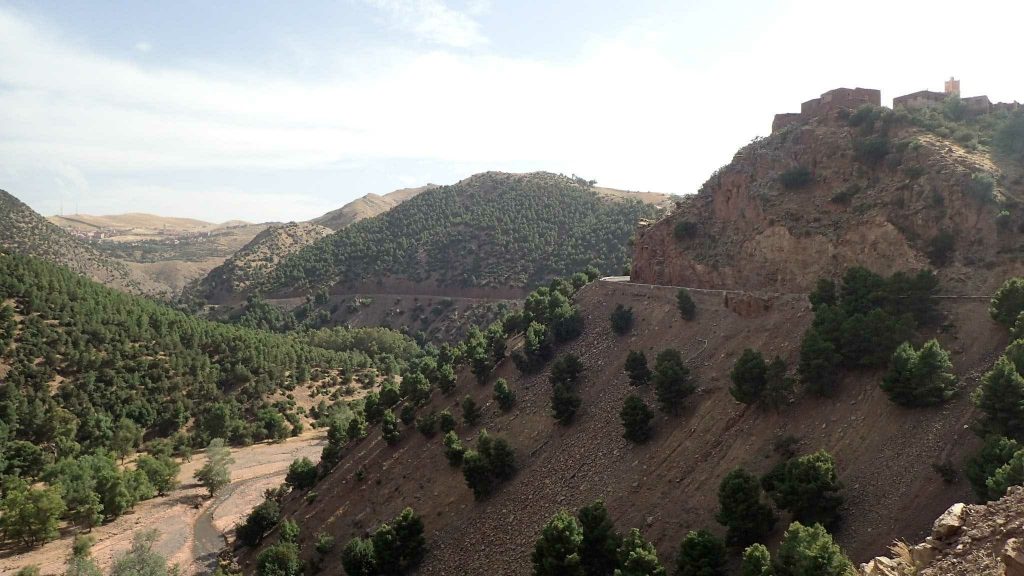
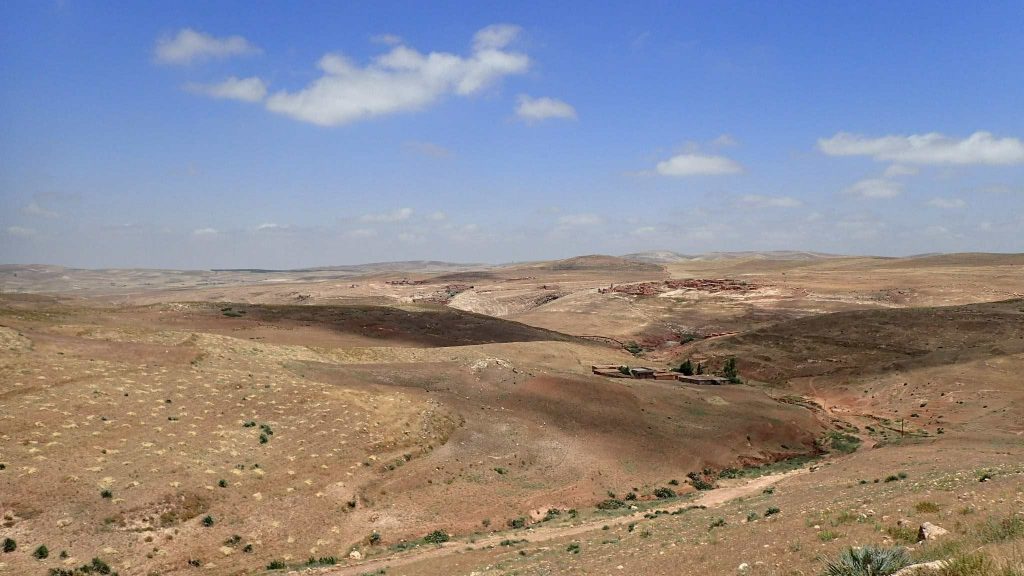
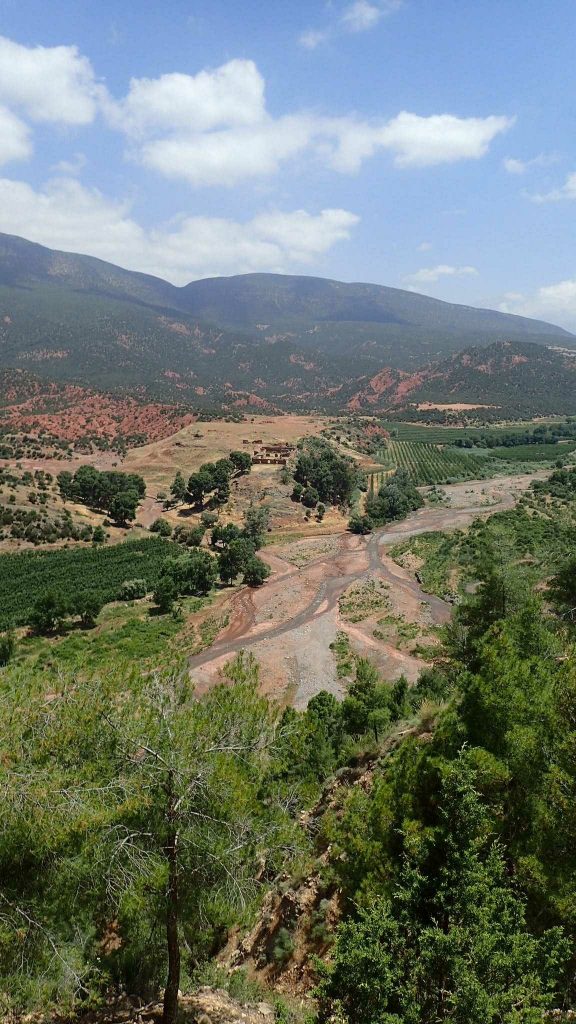
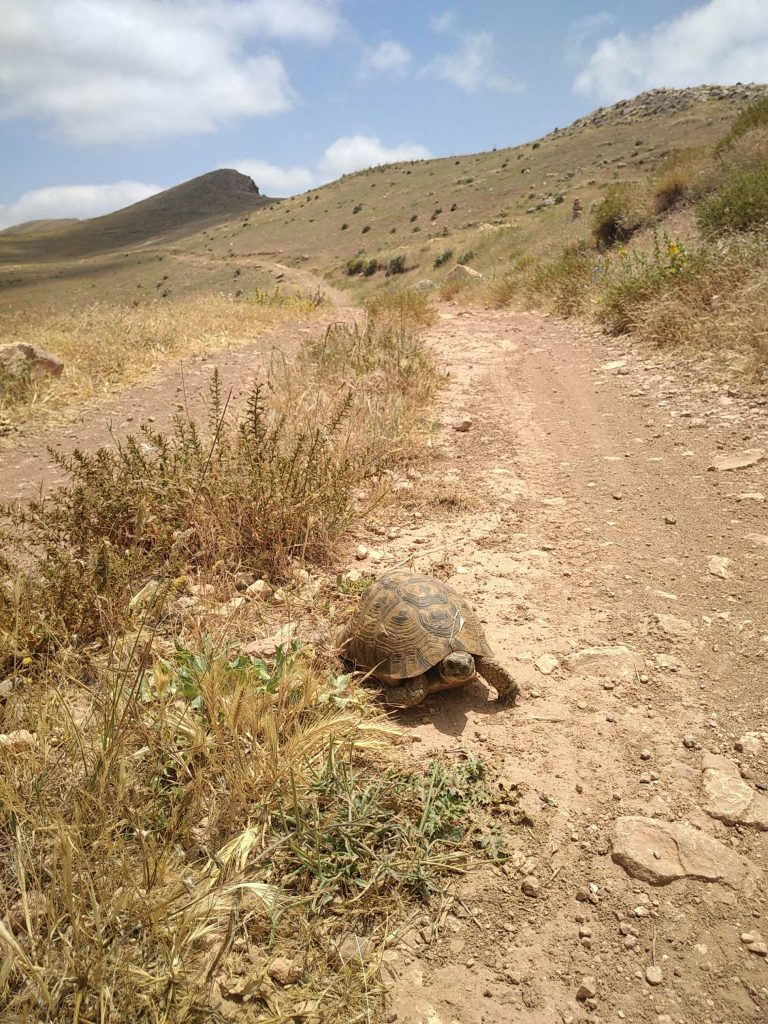
The alarm rang at 3:30 the day of the ascent! Unfortunately, the guide did not show up… no big deal, I saved 50 euros (20 days of food autonomy in Morocco), and avoided doing a guided hike. I then decided to take the road to Agadir. I will have the opportunity to do other summits during this long journey!
Last straight line
The advantage of the mountains is its fresh air. The suffering is thus lessened during the climb, and what a climb! The road is narrow but I will meet very few motor vehicles. The few people I meet keep honking to cheer me on, many even stop to take a picture. This group of Australian tourists tells me “it’s the fifth time we see you! Where are you going?”
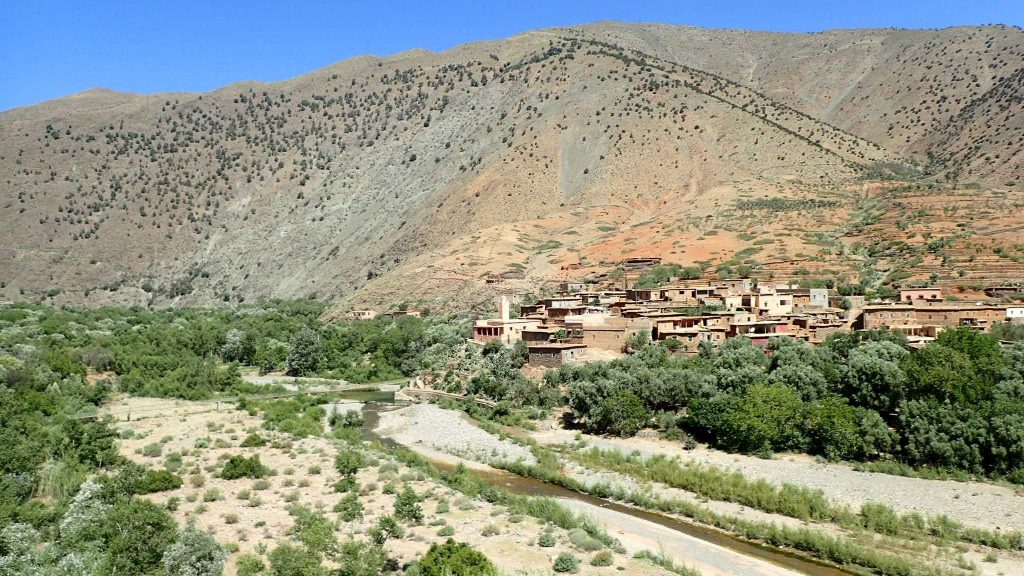
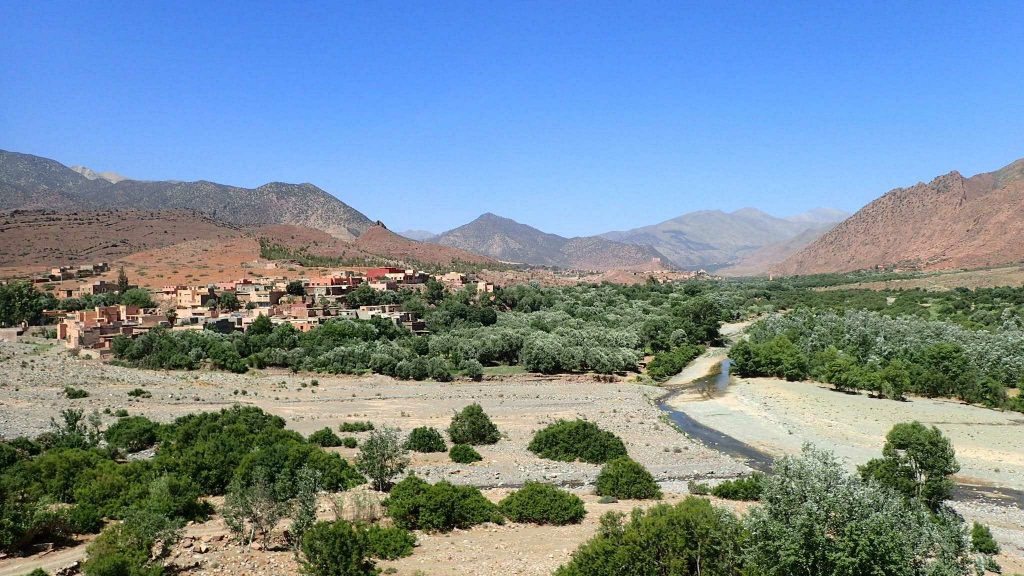
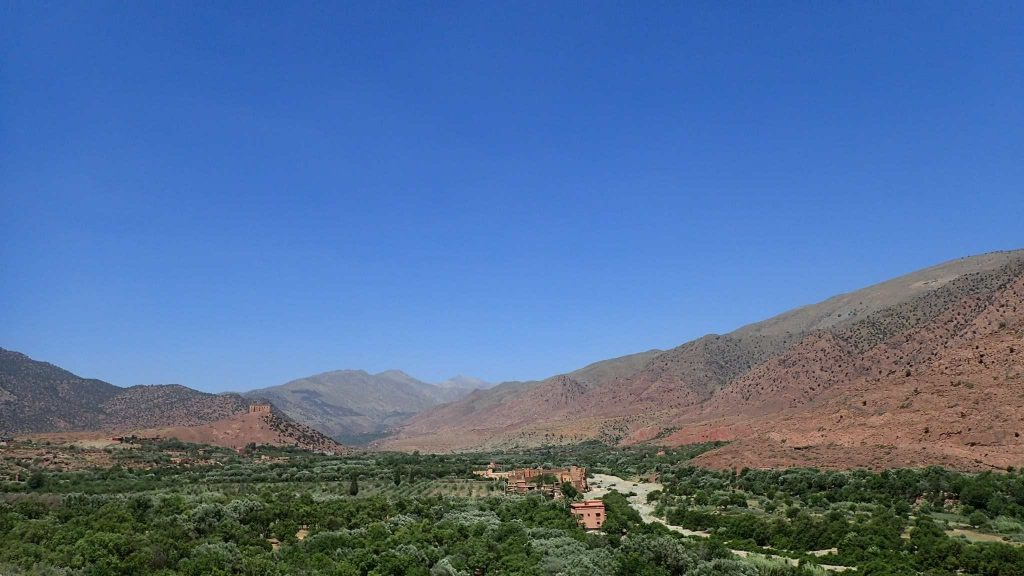
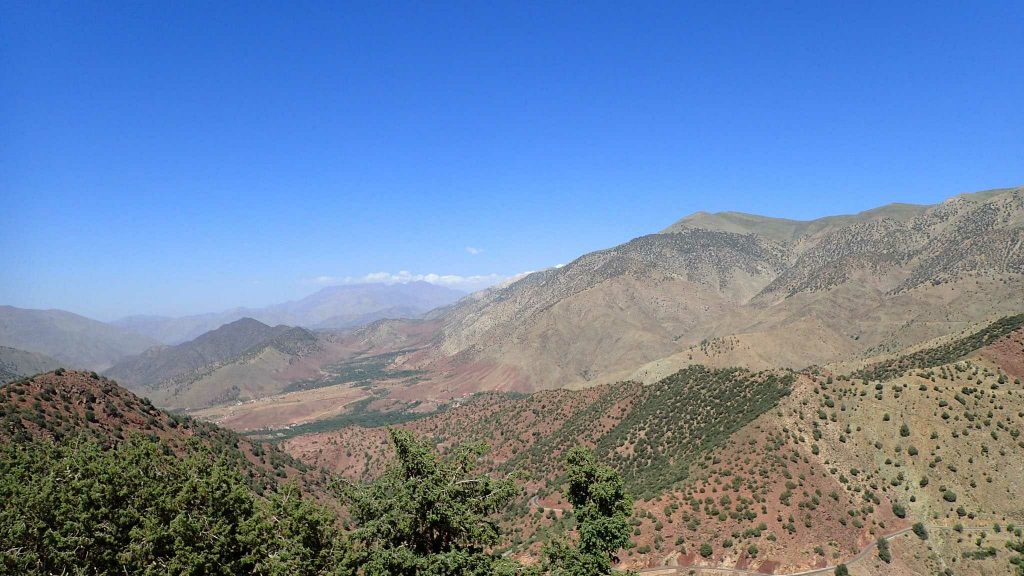
Three Moroccans on mopeds pass me several times, I end up asking them if they want to camp with me tonight, they accept but we will not be able to find each other.
Shortly before the pass, I see a group of men playing cards on the side of the road. They cheered me on and pronounced these magic words: “Stop, come to eat!” Immediately said, immediately stopped! They come from Ouirgane, a village right after Asni. They consider themselves a family, and the meal is delicious: watermelons and melons as a starter, then a chicken tagine. Dry biscuits will be served with thyme tea as a dessert. But what a royal collar then!

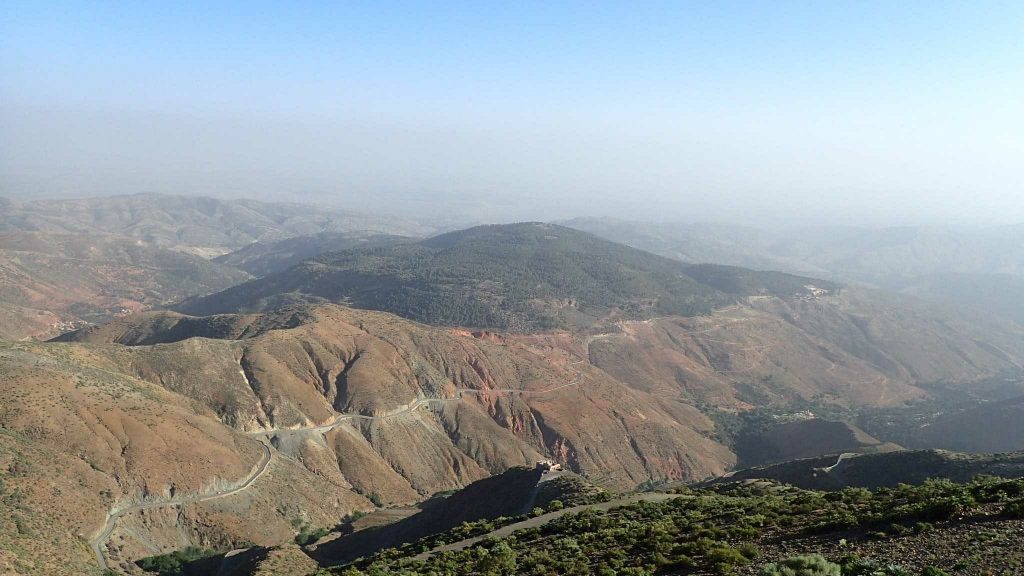
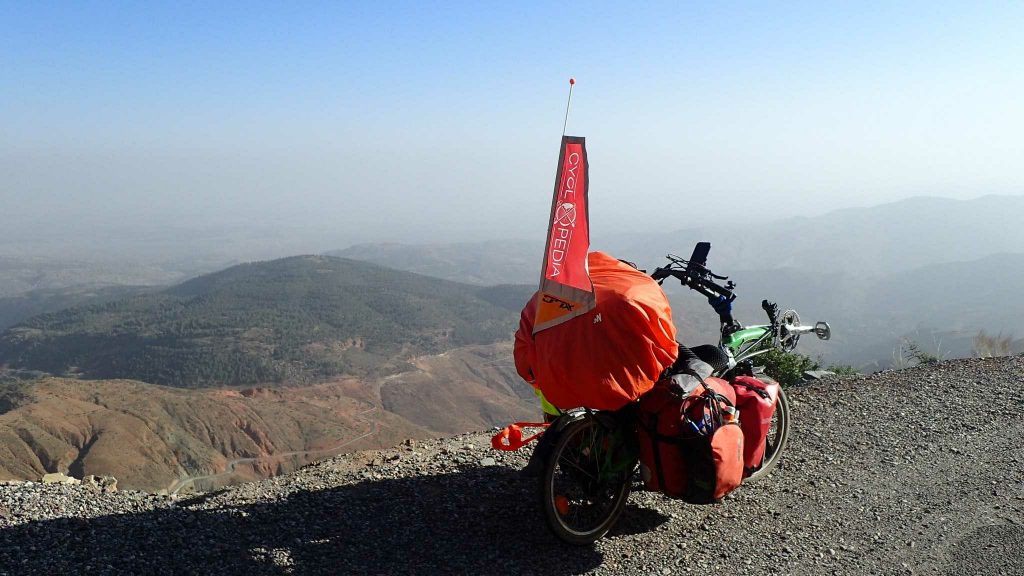
Then I will “push” a little (40km) on the descent. And overnight by the road. The headwind did not make these kilometres as easy as expected.
Transport in Morocco
In some respects Morocco is inspiring in terms of transport efficiency. On others it is less so! First of all, there is a high rate of vehicle filling (sometimes at the expense of safety unfortunately). In France, the occupancy rate of a single car is 1.3 people on average (1.06 on home-to-work trips compared to 1.9 for long distance car2). On 10 trips there would be 7 journeys with a single driver and 3 journeys with one passenger and one driver. It’s hard to find precise figures on the fill rate in Morocco but most of the seen vehicles were full! The filling rate should be close to 4. Car-solism (one person per car) is therefore not (yet) developed but remains the economic dream of car manufacturers (nevertheless a risk for Moroccans). Renault and PSA both have factories here. Renault’s plant produces almost one car per minute (1200 vehicles per day 3), at this rate they can’t really boast that the site is powered by renewable energy (see associated article)!
In short, two other black spots on the Moroccan transport table: two wheels and diesel. Indeed, in 2014 73% of the car fleet was diesel… Two wheels are also a real scourge. Clearly cheaper than a car and almost as convenient, Moroccans quickly adopted it. The problem is that mopeds/motorcycles are less effective in terms of particules filtering. Pollution and its deaths have a bright future ahead of them!
The bus network covers a large part of the territory with different vehicle sizes: from the scooter (three-wheeled motorcycle with a “box”) to the 20-person bus, and the mini-buses (9 to 12 seats). But I didn’t use them. Minibuses are I think an interesting solution to develop in our metropoles (from “developed countries”) for commuting or to connect the periphery to the center. Some hypotheses to make it work (which will be developed later):
- Allow these vehicles to take the emergency lane (already the case in Grenoble for some Transisere buses)
- Have interchange stops
- A “high” frequency at peak times
- Need to do free trial sessions (discovery of service)
I can’t close the transport chapter of Morocco without talking about animals! Cars remain a product of “luxury” for Moroccans, in the countryside mules and horses remain the main means of locomotion (but also transport of goods). The way they are treated is rarely gentle but these animals are very effective! And are especially able to reach villages not accessible by car.
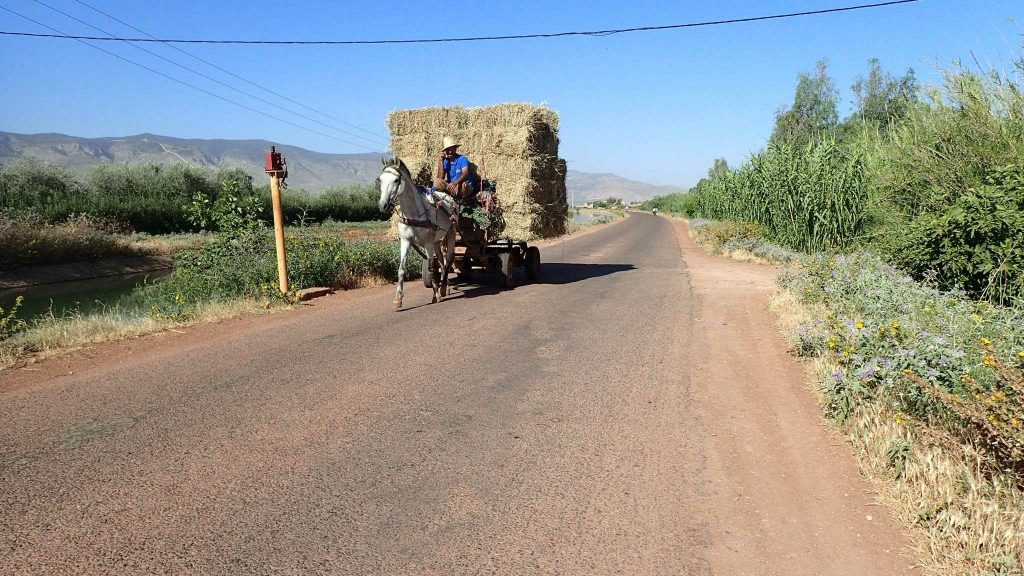
Culinary art
The emblematic dish of the Maghreb is of course the tagine! Of Berber origin, several recipes exist: vegetable, chicken, with different combinations of spices, and so on. With my reduced budget, I never ate it… At the restaurant! But I had the chance to share several meals with Moroccans. Including some tagines!
The ftour (or iftar according to dialects) is the dinner of Ramadan (this term also refers to breakfast outside this period). The main components of this meal are:
- Harira: a tomato soup with lentils or chickpeas. This is usually the entrance
- Various fruit salads: oranges, bananas, apples, cucumber, carrots
- A multitude of typical breads: baghrir (marrocain pancake, also of Berber origin), chapati (Indian cake rather typical of Tunisia), batbout (fried flat bread). Olive oil was often served in bowls to dip bread
- A tagine or meat in sauce (usually chicken)
- Dried dates and pastries for dessert: chabakia (small cake coated with honey and sprinkled with sesame), briouate (honey samosa)
- Several drinks are also served: mint tea (very sweet), squeezed orange juice, homemade lemonade, yoghurt to drink
During these intimate moments with the family I did not dare to take too many pictures (most of the time I did not even think about it actually) but you can find some by typing ftour on your favorite search engine!
- Road accidents in Morocco, consulted in 07/2019
- Car pooling, consulted in 07/2019
- The Renault plant in Tangier, consulted in 07/2019
